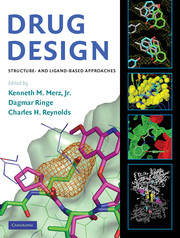Book contents
- Frontmatter
- Contents
- Contributors
- Preface
- DRUG DESIGN
- 1 Progress and issues for computationally guided lead discovery and optimization
- PART I STRUCTURAL BIOLOGY
- PART II COMPUTATIONAL CHEMISTRY METHODOLOGY
- 5 Free-energy calculations in structure-based drug design
- 6 Studies of drug resistance and the dynamic behavior of HIV-1 protease through molecular dynamics simulations
- 7 Docking: a domesday report
- 8 The role of quantum mechanics in structure-based drug design
- 9 Pharmacophore methods
- 10 QSAR in drug discovery
- 11 Predicting ADME properties in drug discovery
- PART III APPLICATIONS TO DRUG DISCOVERY
- Index
- References
9 - Pharmacophore methods
from PART II - COMPUTATIONAL CHEMISTRY METHODOLOGY
Published online by Cambridge University Press: 06 July 2010
- Frontmatter
- Contents
- Contributors
- Preface
- DRUG DESIGN
- 1 Progress and issues for computationally guided lead discovery and optimization
- PART I STRUCTURAL BIOLOGY
- PART II COMPUTATIONAL CHEMISTRY METHODOLOGY
- 5 Free-energy calculations in structure-based drug design
- 6 Studies of drug resistance and the dynamic behavior of HIV-1 protease through molecular dynamics simulations
- 7 Docking: a domesday report
- 8 The role of quantum mechanics in structure-based drug design
- 9 Pharmacophore methods
- 10 QSAR in drug discovery
- 11 Predicting ADME properties in drug discovery
- PART III APPLICATIONS TO DRUG DISCOVERY
- Index
- References
Summary
INTRODUCTION
Paul Ehrlich introduced the pharmacophore concept in the early 1900s while studying the efficacy of dyes and other compounds as potential chemotherapeutic agents. By analogy with chromophores and toxophores, Ehrlich suggested the term pharmacophore to refer to the molecular framework that carries (phoros) the features that are essential for the biological activity of a drug (pharmacon). The modern, widely accepted definition was offered by Peter Gund in 1977: “a set of structural features in a molecule that is recognized at the receptor site and is responsible for that molecule's biological activity.” In practice, the modern definition is implicitly restricted to cover only specific, noncovalent interactions between a molecule and receptor. Thus a pharmacophore model is not concerned with binding that occurs solely as a result of short-lived surface-to-surface hydrophobic interactions, nor binding that involves the formation of covalent bonds.
Although a pharmacophore model codifies the key interactions between a ligand and its biological target, neither the structure of the target nor even its identity is required to develop a useful pharmacophore model. For this reason, pharmacophore methods are often considered to be indispensable when the available information is very limited, for example, when one knows nothing more than the structures of a handful of actives. However, pharmacophore approaches can also be vital for accelerating discovery efforts when more extensive data are available by providing a means of superimposing structures for 3D quantitative structure/activity relationship (QSAR) development, or by acting as a rapid prefilter on real or virtual libraries that are too large for routine treatment with more expensive structure-based techniques, such as docking.
- Type
- Chapter
- Information
- Drug DesignStructure- and Ligand-Based Approaches, pp. 137 - 150Publisher: Cambridge University PressPrint publication year: 2010
References
- 5
- Cited by



